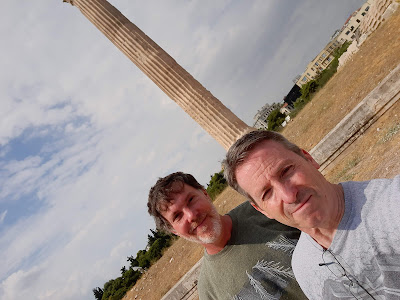Last year, the Baltimore Comic-con was canceled due to the pandemic, but this year, thanks to everyone showing either a vaccination card or a recent negative COVID test to get in, it was back on! And, since on television (the CW Network's superhero shows) aired the famous DC Comics storyline of "Crisis on Infinite Earths"- people knew my character- I was Superman, but not the Superman of Earth-1 (that most people know) - I was Superman of Earth 96 (the Kingdom Come Superman). One of the days, I attended with my friend Grey (whom I call Star boy from the Legion of superheroes - and he calls me Lightning Lad, from the same group). Today's blog shows photos of the heroes and villains I met in costume!
(Photo: Villain Carnage and Rob as Kingdom Come Superman)WHO IS THE KINGDOM COME SUPERMAN? - This version of Superman resides on Earth-96 and dealt with a significant tragedy when Batman's villain, the Joker, gassed the Daily Planet, which took the lives of Lois Lane and his fellow co-workers. Following the incident, Clark became the new editor-in-chief and took on a red and black s-shield to remind himself that hope will always rise out of darkness. Covering the Yellow on his S-shield was also a tribute to Lois, Jimmy and Perry White who all perished from the Joker's deadly visit.
CARNAGE THE VILLAIN -
(Photo: Ghost Rider!)
WHO IS GHOST RIDER? - Marvel Comics' Ghost Rider is stunt motorcyclist Johnny Blaze, who, in order to save the life of his father, agreed to give his soul to "Satan" (later revealed to be an arch-demon named Mephisto). At night and when around evil, Blaze finds his flesh consumed by hellfire, causing his head to become a flaming skull. He rides a fiery motorcycle and wields blasts of hellfire from his body, usually from his skeletal hands.
PHOTO: The Wally West version of the Flash and Superman Earth 96)
WHO IS WALLY WEST, NOW THE FLASH ? - Barry Allen is the Flash of Earth 1, but his nephew Wally got the same speed powers (from an identical freak accident with chemicals and a bolt of lightning) and donned the Flash costume, when Barry was lost in time. Wally's red hair is a sign of the character, and this guy got it perfectly.)
(Photo: Grey and Rob at Comic-con!)
























































